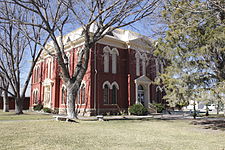Brewster County, Texas
| Brewster County, Texas | |
|---|---|

The Brewster County Courthouse in Alpine
|
|
 Location in the U.S. state of Texas |
|
 Texas's location in the U.S. |
|
| Founded | 1887 |
| Named for | Henry Percy Brewster |
| Seat | Alpine |
| Largest city | Alpine |
| Area | |
| • Total | 6,192 sq mi (16,037 km2) |
| • Land | 6,184 sq mi (16,016 km2) |
| • Water | 8.5 sq mi (22 km2), 0.1% |
| Population (est.) | |
| • (2015) | 9,145 |
| • Density | 1.5/sq mi (1/km²) |
| Congressional district | 23rd |
| Time zone | Central: UTC-6/-5 |
| Website | www |
Brewster County is a county located in the western part of the U.S. state of Texas. As of the 2010 census, the population was 9,232. Its county seat and only city is Alpine. The county is named for Colonel Henry Percy Brewster, a Secretary of War for the Republic of Texas.
Brewster County is the largest county by area in the state, over three times the size of the state of Delaware, and more than 500 square miles (1,300 km2) bigger than Connecticut. It is one of the nine counties that comprise the Trans-Pecos region of West Texas, and borders Mexico.
Oilman, geologist, and historian Clayton Wheat Williams, Sr., operated a ranch near Alpine in Brewster County, though his residence was in .
Paleo-Indian hunter-gatherers existed there at least 9000 years ago. Mescalaro Apaches emerged later and conducted raids that discouraged settlers. Between 1779 and 1787, Col. Juan de Ugalde drove the Mescalaros back across the Rio Grande and into the Chisos Mountains. The three leading Mescalero chiefs, Patula Grande, Quemado, and Zapato Tuerto, agreed in March 1789 to submit to Spanish rule.Comanche raiding parties continued through much of the 19th century.
Spanish explorers Álvar Núñez Cabeza de Vaca in 1535 and Antonio de Espejo in 1583 crossed Brewster County on their way to La Junta de los Ríos, the junction of the Rio Grande and the Rio Conchos.
...
Wikipedia
